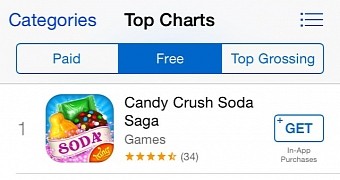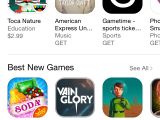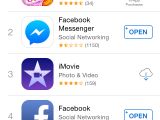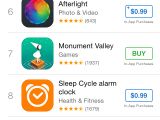In a surprising move, Apple changed the label for the download button in AppStore from “Free” to “Get.” At first sight, this is simply strange.
Sure, I get the logic behind this move. Some apps are not really Free, because of in-app purchases and the customers feel sometimes betrayed by the “free” tag. However, the new tag is confusing.
This is FREE. Did you GET it?
Almost anyone in the world knows what “Free” means, whether they speak English or not. But who knows whether a non-English speaker understands what “Get” is?
This move is even more surprising because Apple has added the In-app purchases right below the “free” button a long time ago. Also, when you click the Top Charts page on an iOS device, you still see the top navigation bar with 3 main categories: Paid, Free, and Top Grossing.
Too many buttons
Another strange behavior of the buttons in the AppStore is directly linked to inconsistency. Click a button that shows a price tag and it will turn to "BUY." Click the new "Get" button and it will transform into "Install."
If you already have an app installed on your phone and you hit the "Open" button that replaced the price tag, it will switch to that app right away. If you used to have an app and it is no longer installed, you will get the cloud with a down arrow icon. Tap on it and the app will start downloading, but there's no way to stop that download from within the AppStore until it has downloaded a few MBs. Even then, you still have to tap the little square in the circle to stop it. There's no way to pause the download so you can start again from that point on when you are on a more stable (even WiFi) connection. You can only stop it and start from scratch.
What's worse is that all of these were apparently designed that way. So someone from Apple thought it through and said this would be a good idea. Well, it isn't. The user experience is terrible.
The road to "Free"
The "Free" label was acting like a magnet for users. The tag was so popular that developers started to include it in the App icon. That way, the fact that the app was Free was more visible and the user would press the download button much faster.
And the App Store policy changed and developers were not allowed to have written words on their icons for a while. That rule was changed back, but developers were not counting on it. The big "FREE" button next to the name of the app, written in all CAPS was enough to attract customers.
Sure enough, around that time came the moment when everyone was making their apps Free just to take advantage of the in-app purchase option. The customers are happy because they get to try it before they buy and developers get their app into as many handsets as possible.
But then came the developers who were doing it all wrong. Imagine a game that has only one Free Chapter or level and for each additional one you need to pay something extra. How about those games that get difficult and the only way to win is to buy some extra points? It's frustrating and costly.
Apple got into trouble with parents who saw their Credit Cards hijacked by cheap, but repeated in-app purchases. That led to some policy changes and some big refunds. Fortunately, Apple now allows users to get their money back pretty fast and then the AppStore editors deal with the apps.
Another kind of developers are the ones that give their apps and games away for free just to make some money off of banner ads. Remember Flappy bird? According to different news outlets, the Vietnamese-based developer Dong Nguyen made about $50.000 (€39.871) each day just because of the ads in the game. Flappy Bird was popular and addictive so people were spending hours inside the app. Hence the high rate return on his free game, even though there was no in-app purchase option.
And then there's the category of developers that were adding multiple ads or annoying flashing ones just to get the users to pay a one-time in-app purchase fee to get rid of the ads. Surprisingly, this was the elegant way to try a new game or app and I personally paid the 99 cents (70 euro cents) fee a few times to get rid of the ads and say "Thanks" to the developers at the same time.
Confusing the user
Now that you don't see the price right away and you don't see a label that reads "Free," you may be tempted to look for another app. The AppStore may see a change in behavior and paid apps that are cheap may get ahead of the free ones, just because there's no "Free" tag anymore. After all, an app that costs $0.99 (€0.69) is not that expensive.
Getting the user confused is not in Apple's DNA. The company is famous for taking care of three things: the customer, themselves and only then the 3-party developers.
If you think the AppStore is confusing, just let Apple know. They often listen to their users and reverse their decisions.

 14 DAY TRIAL //
14 DAY TRIAL // 


